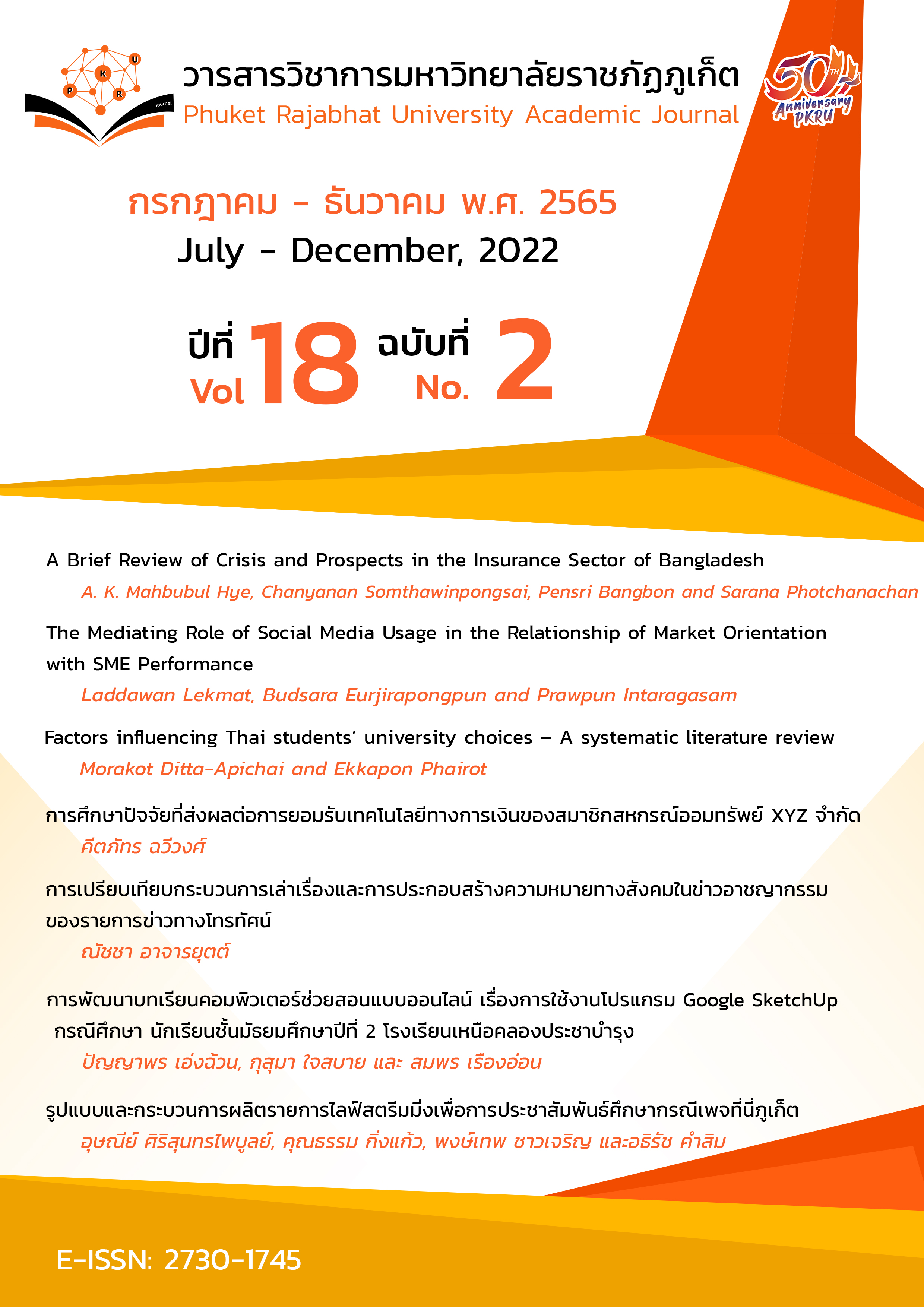The Mediating Role of Social Media Usage in the Relationship of Market Orientation with SME Performance
Main Article Content
บทคัดย่อ
This research aimed to investigate the relationship between market orientation (MO) and firm performance through the mediating effect of social media (SM) usage. Data were collected from a sample of 313 Thai small and medium-sized enterprises (SMEs). The results revealed that MO had indirect effects on business process performance through the mediation of SM usage. In addition, SM usage could predict improved customer relations and services through cost reduction and enhanced information accessibility. This research also provided the suggestion that SMEs may require organizational network resources and dynamic capabilities to link MO to business process performance.
Article Details

อนุญาตภายใต้เงื่อนไข Creative Commons Attribution-NonCommercial-NoDerivatives 4.0 International License.
เนื้อหาและข้อมูลในบทความที่ลงตีพิมพ์ในวารสารวิชาการมหาวิทยาลัยราชภัฏภูเก็ต ถือเป็นข้อคิดเห็นและความรับผิดชอบของผู้เขียนบทความโดยตรง ซึ่งกองบรรณาธิการวารสารฯ ไม่จำเป็นต้องเห็นด้วยหรือร่วมรับผิดชอบใด ๆ
บทความ ข้อมูล เนื้อหา รูปภาพ ฯลฯ ที่ได้รับการตีพิมพ์ในวารสารวิชาการมหาวิทยาลัยราชภัฏภูเก็ต ถือเป็นลิขสิทธิ์ของวารสารวิชาการมหาวิทยาลัยราชภัฏภูเก็ต หากบุคคลหรือหน่วยงานใดต้องการนำทั้งหมดหรือส่วนหนึ่งส่วนใดไปเผยแพร่ต่อหรือเพื่อกระทำการใด ๆ จะต้องได้รับอนุญาตเป็นลายลักษณ์อักษรจากวารสารวิชาการมหาวิทยาลัยราชภัฏภูเก็ตก่อนเท่านั้น
เอกสารอ้างอิง
Abdolvand, M. A., & Merikhnejad, A. (2016). Investigation the effect of market orientation, social media marketing and international experience on global marketing strategy and company performance. International Journal of Life Science & Pharma Research, SP(2), 93–101.
Ahmed, A. M., Ibrahim, S. B., & Hasaballah, A. H. A. (2017). Market sensing, innovation capability and market performance: The moderating role of internal information dissemination. International Journal of Advanced and Applied Sciences, 4(8), 56–67
Ajina, A. S. (2019). The perceived value of social media marketing: An empirical study of online word-of-mouth in Saudi Arabian context. Entrepreneurship and Sustainability Issues, 6(3), 1512–1527.
Al-Badi, A. H., & Al-Qayoudhi, W. S. (2014). Adoption of social networks in business: Study of users and potential users in Oman. International Business and Economics Research Journal, 13(2), 401–418.
Davies, G., Manuel, N., Mistry, D., & Roth, A. (2021). Five areas of growth for digital marketing in ASEAN. Retrieved December 14th, 2021, from https://www.mckinsey.com/featured-insights/asia-pacific/five-areas-of-growth-for-digital-marketing-in-asean.
Durkin, M., McGowan, P., & McKeown, N. (2013). Exploring social media adoption in small to medium-sized enterprises in Ireland. Journal of Small Business and Enterprise Development, 20(4), 716–734.
Dutot, V., & Bergeron, F. (2016). From strategic orientation to social media orientation. Journal of Small Business and Enterprise Development, 23(4), 1165–1190.
Foltean, F. S., Trif, S. M., & Tuleu, D. L. (2019). Customer relationship management capabilities and social media technology use: Consequences on firm performance. Journal of Business Research, 104, 563–575.
Fornell, C., & Larcker, D. F. (1981). Evaluating structural equation models with unobservable variables and measurement error. Journal of Marketing Research, 18(1), 39–50.
Franco, M., Haase, H., & Pereira, A. (2016). Empirical study about the role of social networks in SME performance. Journal of Systems and Information Technology, 18(4), 383–403.
Gellynck, X., Banterle, A. Kuhne, B. Carraresi, L., & Stranieri, S. (2012). Market orientation and marketing management of traditional food producers in the EU. British Food Journal, 114(4), 481–499.
Hair, J. F., Black, W. C., Babin, B. J., Anderson, R. E., & Tatham, R. L. (2006). Multivariate Data Analysis (6th ed.). Pearson Prentice Hall.
Kajalo, S., & Lindblom, A. (2015). Market orientation, entrepreneurial orientation and business performance among small retailers. International Journal of Retail & Distribution Management, 43(7), 580–596.
Kim, A. J., & Ko, E. (2012). Do social media marketing activities enhance customer equity? An empirical study of luxury fashion brand. Journal of Business Research, 65(10), 1480–1486.
Kline, R. B. (2005). Principles and practice of structural equation modeling. The Guilford Press.
Mamun, A. A., Mohiuddin, M., Fazal, S. A., & Ahmad, G. B. (2018). Effect of entrepreneurial and market orientation on consumer engagement and performance of manufacturing SMEs. Management Research Review, 41(1), 133–147.
Masa’deh, R. E., Al-Henzab, J., Tarhini, A., & Obeidat, B. Y. (2018). The associations among market orientation, technology orientation, entrepreneurial orientation and organizational performance. Benchmarking: An International Journal, 25(8), 3117–3142.
Nurfarida, I. N., Sarwoko, E., & Arief, M. (2021). The Impact of Social Media Adoption on Customer Orientation and SME Performance: An Empirical Study in Indonesia. The Journal of Asian Finance, Economics and Business, 8(6), 357–365.
OSMEP. (2020). SMEs White Paper 2020. Retrieved December 14th, 2021, from https://www.sme.go.th/upload/mod_download/download-20201005123037.pdf.
Parveen, F., Ismawati, N., & Ainin, S. (2016). Social media’s impact on organizational performance and entrepreneurial orientation in organizations. Management Decision, 54(9), 2208–2234.
Prahalad, C., & Hamel, G. (2006). The core competence of corporation. Harvard Business Review, 69(3), 275–292.
Tajvidi, R., & Karami, A. (2017). The effect of social media on firm performance. Computers in Human Behavior, 115(3), 1–10.
Teece, D. J. (2007). Explicating dynamic capabilities: The nature and microfoundations of (sustainable) enterprise performance. Strategic Management Journal, 28(13), 1319-1350.
Teece, D. J., Pisano, G., & Shuen, A. (1997). Dynamic capabilities and strategic management. Strategic Management Journal, 18(7), 509–533.
Trainor, K. J., Andzulis, J., Rapp, A., & Agnihotri, R. (2014). Social media technology usage and customer relationship performance: A capabilities-based examination of social CRM. Journal of Business Research, 67(6), 1201–1208.
Uribe-Saavedra, F., Josep, R., & Llonch, J. (2013). Is social media marketing really working?: Its impact on the relationships among market orientation, entrepreneurial orientation, and business performance. In El-Gohary, H., & Eid, R, E-Marketing in developed and developing countries (pp. 174–193). Business Science Reference.
Yu, X., Nguyen, B, & Chen, Y. (2016). Internet of things capability and alliance: entrepreneurial orientation, market orientation and product and process innovation. Internet Research, 26(2), 402–434.


